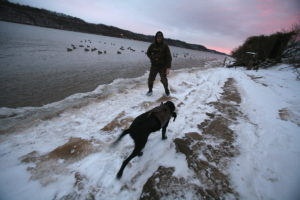BY Kevin Kelly
Kentucky is drawing national attention after dramatically improving the accuracy of harvest and participation information collected from its waterfowl and migratory bird hunters.

The Harvest Information Program (HIP) provides state and federal biologists with data to generate reliable estimates of migratory bird hunter activity and harvest. The estimates are used to help shape season dates, bag limits and population management.
In the past, Kentucky’s data left much to be desired. But a new report from the U.S. Fish and Wildlife Service shows that requiring waterfowl and migratory bird hunters to fill out the HIP survey on the Kentucky Department of Fish and Wildlife Resources’ website is having the desired effect.
Kentucky’s data is better than ever. Because of its success, the state’s system is being considered for implementation on a national level.
“It’s a pretty big deal,” said John Brunjes, migratory bird program coordinator for Kentucky Fish and Wildlife.
The department shifted the HIP survey online in 2015. Waterfowl and migratory bird hunters fill it out through the “My Profile” feature at fw.ky.gov. The survey asks the hunter if they plan to hunt doves, ducks, geese, woodcock or other migratory birds during the current license year. If the respondent hunted those species the previous license year, they are asked to provide additional information about the number of each species harvested. The survey takes about 5 minutes to complete and is a requirement in order to legally hunt waterfowl and migratory birds in Kentucky.
The U.S. Fish and Wildlife Service report looks at migratory bird hunter activity and harvest during the 2014-15 and 2015-16 seasons and shows big improvements in the accuracy of Kentucky’s estimates.
“We went from one of the worst levels of precision in the country to one of the very best,” Brunjes said.
Improvements were seen across the board. The duck and goose estimates illustrate the significant gains in accuracy after the HIP survey went online.
Kentucky’s duck harvest for 2014-15 was estimated at 101,200 but that number carried a 72 percent margin of error. The margin of error improved to 15 percent for 2015-16 when the statewide duck harvest was an estimated 129,300. The accuracy of the state’s goose harvest estimate improved from a 76 percent margin of error at 17,100 to 28,900 with a 15 percent margin of error.
The online survey also helped distill hunter activity estimates. The 2014-15 estimates of duck and goose hunters in Kentucky carried a 48 percent margin of error. The 2015-16 estimates showed significant improvements: down to a 17 percent margin of error for the estimate of duck hunters and 11 percent for goose hunters.
“If I know hunters shot 120,000 ducks, plus or minus 15 percent, then we can be more liberal in the way we set seasons,” Brunjes said. “If we know we’re within 50 percent of the number, it might be 100,000 or it might be 200,000, I have to be much more conservative than you would be when you can home in on that number.
“Now, when somebody asks me, how many wood duck hunters do you have or how many dove hunters do you have, I have some confidence in answering that question. How many ducks did we shoot in Kentucky last year? We shot about 120,000 versus we shot somewhere between 50,000 and 200,000.”
FAST START: Good weather and more seasonable temperatures greeted deer hunters for the start of Kentucky’s modern firearm season on Saturday, Nov. 12.
The opening weekend harvest of 41,796 deer was the second highest on record behind the 44,314 deer taken on opening weekend of modern firearm season in 2015.
Modern firearm season continues through Nov. 21 in counties assigned to Zones 3 and 4 and through Nov. 27 in Zones 1 and 2.
Author Kevin Kelly is a staff writer for Kentucky Afield magazine, the official publication of the Kentucky Department of Fish and Wildlife Resources. Get the latest from Kevin and the entire Kentucky Afield staff by following them on Twitter: @kyafield.


Be the first to comment